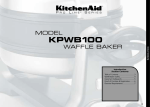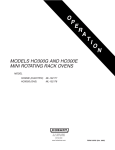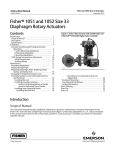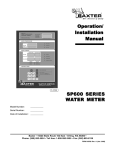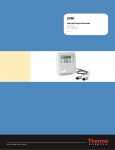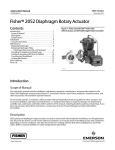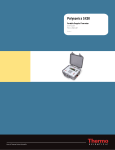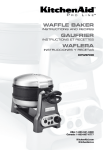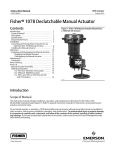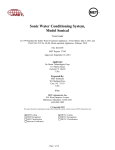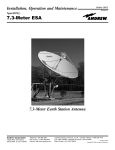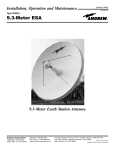Download OV300G & OV300E MINI ROTATING RACK OVENS
Transcript
MODEL
OV300E (ELECTRIC)
OV300G (GAS)
ML-132495
ML-132494
Model Number:
___________
Serial Number:
___________
Date of Installation:
___________
OV300G & OV300E
MINI ROTATING
RACK OVENS
Baxter Manufacturing Co. • 19220 State Route 162 East • Orting, WA 98360 •
Phone: (360) 893-5554 • Toll free: 1-800-280-2495 • Fax: (360) 893-6128
FORM 36704 Rev. B (July 2009)
IMPORTANT FOR YOUR SAFETY
THIS MANUAL HAS BEEN PREPARED FOR PERSONNEL QUALIFIED TO INSTALL GAS
EQUIPMENT, WHO SHOULD PERFORM THE INITIAL FIELD START-UP AND ADJUSTMENTS
OF THE EQUIPMENT COVERED BY THIS MANUAL.
POST IN A PROMINENT LOCATION THE INSTRUCTIONS TO BE FOLLOWED IN THE EVENT
THE SMELL OF GAS IS DETECTED. THIS INFORMATION CAN BE OBTAINED FROM THE
LOCAL GAS SUPPLIER.
IMPORTANT
IN THE EVENT A GAS ODOR IS DETECTED, SHUT DOWN UNITS
AT MAIN SHUTOFF VALVE AND CONTACT THE LOCAL GAS
COMPANY OR GAS SUPPLIER FOR SERVICE.
FOR YOUR SAFETY
DO NOT STORE OR USE GASOLINE OR OTHER FLAMMABLE
VAPORS OR LIQUIDS IN THE VICINITY OF THIS OR ANY OTHER
APPLIANCE.
IMPROPER INSTALLATION, ADJUSTMENT,
ALTERATION, SERVICE OR MAINTENANCE CAN CAUSE
PROPERTY DAMAGE, INJURY OR DEATH. READ THE
INSTALLATION, OPERATING AND MAINTENANCE INSTRUCTIONS
THOROUGHLY BEFORE INSTALLING OR SERVICING THIS
EQUIPMENT.
IN THE EVENT OF A POWER FAILURE, DO NOT ATTEMPT TO
OPERATE THIS DEVICE.
KEEP AREA AROUND OVEN CLEAR OF COMBUSTIBLES. DO
NOT OBSTRUCT COMBUSTION AND VENTILATION OPENINGS
ON THE OVEN.
This manual has been prepared to provide information in accordance with
ANSI Z83.11-2000 for gas equipment.
–2–
TABLE OF CONTENTS
GENERAL ............................................................................................................................................. 4
INSTALLATION ..................................................................................................................................... 4
Unpacking........................................................................................................................................ 4
Location ........................................................................................................................................... 5
Installation Codes and Standard ..................................................................................................... 5
Assembly ......................................................................................................................................... 5
Gas Connections ............................................................................................................................. 6
Testing the Gas Supply System....................................................................................................... 6
Ventilation ........................................................................................................................................ 6
Plumbing Connections..................................................................................................................... 6
Drain Connections ........................................................................................................................... 7
Electrical Connections ..................................................................................................................... 7
OPERATION.......................................................................................................................................... 8
Controls ........................................................................................................................................... 8
Food Service Steam Mode ............................................................................................................ 13
Safety Alarm .................................................................................................................................. 13
Programming the Oven ................................................................................................................. 14
Using the Programs ....................................................................................................................... 17
Customized Operation ................................................................................................................... 18
Shutdown....................................................................................................................................... 20
CLEANING .......................................................................................................................................... 21
MAINTENANCE .................................................................................................................................. 22
General .......................................................................................................................................... 22
Service and Parts Information ....................................................................................................... 22
REMOVING THE RACK ...................................................................................................................... 23
To Remove Rack from Oven ......................................................................................................... 23
TROUBLESHOOTING ........................................................................................................................ 25
Burners Will Not Light (Gas Ovens Only) ...................................................................................... 25
Safety Alarm .................................................................................................................................. 25
Circulation Motor ........................................................................................................................... 25
Rack Rotation ................................................................................................................................ 25
Service and Parts Information ....................................................................................................... 25
OWNER PREVENTIVE MAINTENANCE PROCEDURES ................................................................. 26
Introduction .................................................................................................................................... 26
Preventive Maintenance Procedures............................................................................................. 26
–3–
OPERATION AND CARE OF
MODELS OV300G AND OV300E MINI ROTATING
RACK OVENS
SAVE THESE INSTRUCTIONS
GENERAL
Models OV300G (Gas) and OV300E (Electric) Mini Rotating Rack Ovens feature the choice of four rack
configurations:
•
Eight 18" x 26" (45.7 cm x 66 cm) pan capacity rack with 4" (10.2 cm) slide spacing
•
Six 18" x 26" (45.7 cm x 66 cm) pan capacity rack with 5.31" (13.5 cm) slide spacing
•
Ten 18" x 26" (45.7 cm x 66 cm) pan capacity rack with 3.2" (8.1 cm) slide spacing
•
Twelve 18" x 26" (45.7 cm x 66 cm) pan capacity rack with 2.8" (7.1 cm) slide spacing
All oven rack options can be ordered in an end-load design. The six and eight pan options can be ordered
in a side-load design. A mechanism in the ceiling rotates the rack during baking.
Model OV300G is rated at 95,000 BTU/hr (natural or propane gas). Model OV300E is rated at 18.0 kW
(electric).
Baxter Mini Rotating Rack Ovens are produced with quality workmanship and material. Proper installation,
usage and maintenance of the rack oven will result in years of satisfactory performance.
It is suggested that you thoroughly read this manual and carefully follow the instructions provided.
INSTALLATION
In order to validate the warranty, the start-up must be performed by an Authorized Service Representative.
Before installing, verify that the electrical service(s) and type of gas supply (natural or propane) agree with
the specifications on the data plate located on top of the oven. If the supply and equipment requirements
do not agree, do not proceed with the installation. Contact an authorized Bakery Systems service office
immediately.
UNPACKING
This oven was inspected before leaving the factory. The transportation company assumes full responsibility
for safe delivery upon acceptance of the shipment. Immediately after unpacking, check for possible shipping
damage. If the oven is found to be damaged, save the packaging material and contact the carrier within
15 days of delivery.
Carefully unpack the oven and place it in a work-accessible area as near to its final installed position as
possible. Remove protective covering from exterior surfaces prior to placing oven in final location.
–4–
LOCATION
The OV300G and OV300E Mini Rotating Rack Ovens must have the following minimum clearances to
combustibles:
•
Back and sides: 0"
•
Bottom: 0"
•
Top: 18" (45.7 cm)
NOTE: Minimum 24" clearance needed for service access on the right-hand side. If right-hand side is
within 30" of radiant heat or grease vapor source, vent guard is required.
Be sure that electrical, water and drain connections are accessible and can be made per local and national
codes. The equipment area must be kept free and clear of combustible substances.
Do not obstruct the flow of combustion and ventilation air. Adequate clearance for air openings into the
combustion chamber must be provided. Make sure there is an adequate supply of air in the room to replace
air taken out by the ventilating system.
INSTALLATION CODES AND STANDARD
The oven must be installed in accordance with:
In the United States of America:
1. State and local codes.
2. National Fuel Gas Code, ANSI-Z223.1 (latest edition). Copies may be obtained from The American
Gas Association, Inc.; 1515 Wilson Blvd.; Arlington, VA 22209.
3. National Electrical Code, ANSI/NFPA-70 (latest edition).
In Canada:
1. Local codes.
2. CAN/CGA-B149.1 Natural Gas Installation Code (latest edition).
3. CAN/CGA-B149.1 National Fuel Gas Code (latest edition), available from The Canadian Gas
Association; 178 Rexdale Blvd.; Etobicoke, Ontario; Canada M9W 1R3.
ASSEMBLY
The oven must be installed on a stand, proofer cabinet or any noncombustible surface.
The oven must be sealed to the stand with an NSF-approved sealant, such as Dow Corning 732 or GE
RTV108.
Secure the oven to the proofer or stand using the provided tie-down brackets, which mount on the front
and rear of the oven.
Oven Mounted on a Stand or Proofer with Caster
For an appliance equipped with casters, instructions that (1) the installation shall be made with a connector
that complies with the Standard for Connectors for Movable Gas Appliances, ANSI Z21.69 or Connectors
for Moveable Gas Appliances, CAN/CGA-6.16, and a quick-disconnect device that complies with the
Standard for Quick-Disconnect Devices for Use With Gas Fuel, ANSI Z21.41, or Quick Disconnect Devices
for Use with Gas Fuel, CAN1-6.9, (2) adequate means must be provided to limit the movement of the
appliance.
–5–
GAS CONNECTIONS
Gas supply connections and any pipe joint compound must be resistant to the action of propane
gases.
The OV300G is an indirect gas-fired oven, consisting of a heat exchanger with eight independent, U-shaped
tubes, each with a separate in-shot burner rated at 11,875 BTU/hr for a total input of 95,000 BTU/hr.
Prior to lighting, check all joints in the gas supply line for leaks. Use soap and water
solution. Do not use an open flame.
TESTING THE GAS SUPPLY SYSTEM
When gas supply pressure exceeds 1/2 psig (3.45 kPa), the oven and its individual shutoff valve must be
disconnected from the gas supply piping system.
When gas supply pressure is 1/2 psig (3.45 kPa) or less, the oven should be isolated from the gas supply
system by closing its individual manual shutoff valve.
VENTILATION
Information on the construction and installation of ventilating hoods may be obtained from the standard
for Vapor Removal from Cooking Equipment, NFPA No. 96 (latest edition), available from the National
Fire Protection Association, Batterymarch Park, Quincy, MA 02269.
Exhaust Fan Interlock
A connection point (maximum 5-amps) is provided for Indirect Vent (Exhaust Hood) or optional Direct Vent
(Draft Hood). It is located behind the right side service panel adjacent to the 120 V power connection.
Consult local codes for vent interlock requirements.
Indirect Vent (Under Exhaust Hood) - Standard
Locate the oven under an exhaust hood with adequate overhangs and exhaust rates to completely capture
the by-products of combustion discharged from the flue. From the termination of the flue to the filters of
the hood venting system, a minimum clearance of 18" (45.7 cm) must be maintained. The hood exhaust
fan can be electrically interlocked with the oven.
PLUMBING CONNECTIONS
Water and waste piping and connections shall comply with the International Plumbing Code 2003,
International Code Council (ICC), or to the Uniform Plumbing Code 2003, International Association of
Plumbing and Mechanical Officials (IAPMO).
Plumbing connections must comply with applicable sanitary, safety and plumbing
codes and provide adequate backflow protection to comply with applicable federal, state and local
codes.
Oven water supply should have a hardness of 4 to 6 grains per gallon, pH of 6.5 to 8.0 and chlorides less
than 30 PPM. Water condition outside of these requirements may void the warranty. Please consult your
local water company and/or water condition dealer before installing oven.
Connect the cold water supply to the 1/2" NPT incoming water connection located at the rear of the oven.
Water supply should have a pressure of 30 to 75 psi (207 to 517 kPa) when the steam solenoid is open.
–6–
DRAIN CONNECTIONS
Connect a 1/2" drain line to the 1/2" NPT drain connection located at the rear of the oven. Route the drain
line to a floor drain, allowing a minimum 1" air gap between the drain line outlet and floor drain.
If oven is being installed on an HPC800 Proofing Cabinet, it is recommended that separate drain lines
be provided. If it is necessary to interconnect the oven and proofer drains, provide a vent opening in the
drain line above the oven drain connection location. Adequate drop must be provided such that the oven
drain will not flood the proofer cabinet.
ELECTRICAL CONNECTIONS
Electrical and grounding connections must comply with the applicable portions of
the National Electrical Code and/or other local electrical codes.
Disconnect the electrical power to the machine and follow lockout / tagout
procedures.
Appliances equipped with a flexible electric supply cord are provided with a
three-prong grounding plug. This plug must be connected into a properly grounded three-prong
receptacle. If the receptacle is not the proper grounding type, contact an electrician. Do not remove
the grounding prong from this plug.
The wiring diagram is located behind the side service panel on the right side of the oven.
Do not connect the OV300G gas model to the electrical supply until after gas
connections have been made.
The OV300E is an electrically heated oven consisting of six W-shaped elements, each rated at 3.0 kW
for a total input of 18.0 kW. The electrical input is shown in the table below.
HEATING CIRCUIT SUPPLY VOLTAGE
Volts
208
240
480
Hertz
50-60
50-60
50-60
Phase
3
3
3
Amps
50
43
22
Both gas and electric ovens require a dedicated 15-amp, 110 V 50 Hz or 120 V 60 Hz, single-phase supply
with ground, connected at the control circuit terminal block located behind the right side service panel. If
oven is installed in conjunction with an HPC800 Proofing Cabinet, a separate 120 V supply is required
for the proofer.
–7–
OPERATION
The mini-rack oven and its parts are hot. Use care when operating, servicing or
cleaning the oven.
CONTROLS
POWER
AUTO
ON
OFF
AM
ON/OFF
TIMER
PM
AUTO
ON
TIME
AUTO
OFF
TIME
TIMER
ON
OFF
OVEN
TEMP
SET
TEMP
HEAT ON
BAKE
START
TIMER
ON
MINUTES SET
MINUTES REMAINING
STEAM
TIMER
STOP
ON
SECONDS
AIRFLOW
DELAY
ON
MINUTES
PROGRAM
STEPS
1
2
3
4
COOL
DOWN
VENT
–8–
Control Guide - Advanced
BUTTON
ACTION
DISPLAY
Press to turn the oven ON or OFF
Control panel displays are lit when the oven is on. Oven
defaults to Program 0. If oven is turned OFF and back
ON within 2 minutes, the oven will come up in the last
mode and oven setting.
AUTO ON/OFF
TIMER
Press to enter current time or time for
oven to automatically turn ON or OFF,
when corresponding Auto On Time or
Auto Off Time button is pressed.
The AUTO ON/OFF TIMER window displays the current
time or the time the oven will automatically turn ON or
OFF.
AUTO ON TIME
Press arrow keys to set the desired
time of oven to automatically turn ON.
The AUTO ON/OFF TIMER window displays the time
the oven will automatically turn ON.
Press arrow keys to set the desired
time of oven to automatically turn OFF.
The AUTO ON/OFF TIMER window displays the time
the oven will automatically turn OFF.
Press to turn the automatic timer ON
or OFF.
The indicator light beside the timer ON/OFF button is lit
when the function is enabled.
Use to enter bake programs.
The SET TEMP window displays the set temperature.
The heat ON light is lit while the oven is heating. The
actual temperature in the oven cavity is displayed in the
OVEN TEMP window.
BAKE TIMER
Press arrow keys to enter the BAKE
time (1 minute increments). Press the
up arrow key to enter additional time at
the end of the bake program.
The BAKE TIMER window displays the amount of time
for the current baking cycle. The minutes set are the
left two digits and minutes remaining are the right two
digits. The windows can be set to display hours and
minutes remaining. The ON light is lit when bake time is
active.
STEAM TIMER
Press to enter the STEAM time
(5-second increments in Bakery mode;
1-second increments in Food Service
mode).
The STEAM TIMER window displays the amount of
time set for the steam cycle. The ON light is lit when the
steam system is active.
AIRFLOW
DELAY
Press to enter into beginning of baking
cycle.
The DELAY TIMER window displays the amount of time
set for the circulation blower delay cycle
0-9 minutes.
Press to start the BAKE TIMER.
The ON light blinks when the BAKE TIMER is active.
Press to stop the BAKE. TIMER or
silence the beeper after the BAKE
TIMER has timed out.
The ON light is off when the BAKE TIMER is inactive.
Press the arrow keys to select a bake
program.
The PROGRAM window displays the number of the
current program.
Use to enter bake programs.
The corresponding indicator light will be lit (1 to 4),
depending on which step is selected.
POWER
ON
OFF
AUTO
ON
TIME
AUTO OFF TIME
AUTO
OFF
TIME
TIMER ON/OFF
TIMER
ON
OFF
SET TEMP
START
STOP
PROGRAM
STEP
–9–
BUTTON
ACTION
DISPLAY
Press to open or close the vent.
The indicator light next to the VENT button is lit when
the vent cycle is enabled.
Use to cool down the oven.
To enable this feature, set a temperature at least 25°F
(14°C) cooler than the oven temperature. Press the
COOL DOWN button. The COOL DOWN mode is exited
when the oven reaches the new set temperature, or if
door is opened when temperature is 25°F (14°C) below
set temperature, or by pressing any button.
VENT
COOL
DOWN
Auto ON/OFF Timer
Setting Clock
Auto ON/OFF Timer display shows the current time of day. To set the clock, the control must be turned on.
Press and hold either of the arrow buttons until the colon between the hours and minutes display stops
blinking. Use the up and down arrow buttons to adjust time of day. After 5 seconds of no use, the colon
will start to blink again.
The oven can be set to turn itself on and off. After the Auto ON/OFF Timer is set, the POWER ON OFF
button can be pressed to turn the oven off. This will not disrupt the AUTO ON/OFF setting. Electrical power
to the oven must remain on.
1. To set the oven to turn on, press and hold the AUTO ON TIME button. The previously entered start
time will appear in the display. Use the UP and DOWN arrows to adjust the start time. Then release
the AUTO ON TIME button.
2. To set the oven to turn off, press and hold the AUTO OFF TIME button. The previously entered end
time will appear in the display. Use the UP and DOWN arrows to adjust the end time. Then release
the AUTO ON TIME button.
3. To enable the automatic start, press the TIMER ON/OFF button until the indicator LED to the right
of the TIMER ON/OFF button is illuminated.
Backup Battery
The clock is backed up by a lithium battery, which keeps the clock circuitry operating when all external
power is off. If the battery becomes low or dead while the external power is off, the display will read 12:00
(12 hr mode) or 0:00 (24 hr mode) and will not increment until a new time is set. The clock will operate
with a dead or missing battery, but must be set each time external power is turned on. Batteries should
be replaced when low or dead to avoid corrosive damage to the circuitry.
– 10 –
Oven Preheat
For best results, the oven must be preheated to bake temperature before baking begins.
1. Press the POWER ON OFF button to turn the oven on.
POWER
ON
OFF
2. Press the UP or DOWN arrows in the TEMP section to enter the desired baking temperature.
OVEN
TEMP
SET
TEMP
HEAT ON
3. Confirm that the doors are closed.
4. Allow 50 minutes after the oven has reached the set temperature for the steam system to charge.
5. The oven is now ready for baking operations.
Basic Operation
The oven and its parts are hot. To prevent burns, use hot pads or protective mitts
when loading or unloading the oven.
Hot air and steam are released from the oven interior when the loading doors are
opened. To avoid burns, open the doors slowly and keep clear of the opening.
1. Preheat the oven. See Oven Preheat.
2. Manually select baking settings:
BAKE
START
TIMER
ON
MINUTES SET
MINUTES REMAINING
STEAM
TIMER
STOP
ON
SECONDS
AIRFLOW
DELAY
ON
MINUTES
•
Press the UP or DOWN arrows next to BAKE TIMER to enter the desired value.
•
Press the UP or DOWN arrows next to STEAM TIMER to enter the desired value.
•
Press the UP arrow next to AIRFLOW DELAY to enter the desired value.
•
The steam and airflow delay settings are optional and can be left at 0 if desired.
3. Slowly open the doors. Wait for the rack to stop. Load the oven. Close the doors.
4. Press the START button. The ON light in the BAKE TIMER window blinks until the timer times out.
5. The oven beeps after the BAKE TIMER times out. Press STOP to silence the beeper.
– 11 –
Operational Hints
•
On the initial startup, the oven temperature will default to the factory setting of 375°F (191°C)
unless changed using customized operations.
•
During a baking cycle, the START and STOP buttons control the BAKE, STEAM and AIRFLOW
DELAY settings only. They have no effect on the oven heat. When the BAKE TIMER times out,
the oven heat stays at the set temperature. Care should be taken not to overbake products.
•
To adjust the temperature during a baking cycle, press the UP or DOWN arrows in the Oven Temp
section to enter the new temperature.
•
To adjust the BAKE, STEAM and AIRFLOW DELAY settings, press the corresponding arrows to
enter the new values. Press START when finished.
•
Circulation blower will pulse during a steam cycle to assist steam distribution. It does not attain full
speed.
•
If the doors are opened at any time during the baking cycle, the TEMP, BAKE TIME, STEAM and
AIRFLOW DELAY settings will pause. Close the doors to resume all functions.
•
The AIRFLOW DELAY option minimizes airflow at the beginning of the baking cycle. The heat is
off while the AIRFLOW DELAY is activated.
•
If the oven temperature is more than 20°F (11°C) higher than the set temperature, and the bake
timer is not activated, the oven will automatically open the VENT. The VENT will remain open until
the oven temperature is within 20°F (11°C) of the set temperature.
•
The oven monitors the heating system by comparing the current oven temperature to the set
temperature. If a problem arises in the heating system or there is a heating system failure, both
temperature displays will flash. If the problem continues, contact your authorized Bakery Systems
service agency.
•
The COOL DOWN feature provides a means of cooling down the oven. To enable this feature, set
a temperature at least 25°F (14°C) cooler than the oven temperature. Press the COOL DOWN
button—the display alternately shows the set temperature and COOL and the vent opens. Additionally,
the doors can be opened and the circulation fan will continue to run. The COOL DOWN mode is
exited by the oven temperature reaching set temperature (25°F (14°C) below set temperature if
doors are opened) or by pressing any button.
•
The oven rack will rotate only after there is time entered into the bake timer and the START button
has been pressed. Rotation will start when both doors are closed. If there is no time entered into
the bake timer, the display will flash. Press STOP and the controller will stop flashing. Once started,
the rack will continue to rotate until a door is opened.
•
Circulation fan will stop running if the oven set point is reached and there is no ("0") time displayed
on the controller.
– 12 –
FOOD SERVICE STEAM MODE
This mode can be used to provide steam on a periodic basis throughout operation. When this mode is
enabled, the STEAM TIMER controls how many seconds of steam are provided to the oven, while a value
entered in the Parameter 14 (P14) setup controls how frequently the steam is operated.
To enable the Food Service Steam mode:
1. Enter the parameter setup mode. (See Entering Setup Mode.)
2. Select Parameter 14.
3. If the BAKE TIMER window displays ‘0’, it is set up for Bakery Mode (factory default). Press the UP
or DOWN arrow buttons to enter FSS mode (display will change to a 3-digit number).
4. Set the desired time between steam cycles using the UP or DOWN arrow buttons. The range is from
300 seconds (5 min.) to 990 seconds (approximately 17 min.), and increments by 10 seconds at a
time.
5. After setting the desired cycle, press the POWER ON OFF button to save the settings.
6. The STEAM TIMER will now operate in 1-second increments, up to 10 seconds, to set the duration
of steaming.
Examples:
‘300’ is selected for P14
‘3’ is entered in STEAM TIMER
= steam is turned on for 3 seconds every 300 seconds (5 min.)
‘990’ is selected for P14
‘3’ is entered in STEAM TIMER
= steam is turned on for 3 seconds every 990 seconds (17 min.)
To return the oven to Bakery Mode, repeat the above process to access P14 and set the value in the BAKE
TIMER window to ‘0’. The STEAM TIMER will now operate in 5-second increments.
SAFETY ALARM (STANDARD FEATURE, NO PARAMETER SETUP REQUIRED)
If the temperature at the probe is in the range of 570 - 600 degrees Fahrenheit for 10 seconds, the unit
will do the following:
1. Shut off all features.
2. Sound an alarm.
3. Flash the OVEN TEMP display (actual temperature is displayed).
4. Display the letters ‘SHdn’ in the BAKE TIMER display.
Disconnect the electrical power to the machine and follow lockout / tagout procedures.
There may be multiple circuits. Be sure all circuits are disconnected.
If gas oven, shut off gas. Contact your authorized Bakery Systems service office.
Do not attempt to restart the oven until it has been inspected by an authorized servicer.
– 13 –
PROGRAMMING THE OVEN
Single Step Programming
The program menu stores up to 99 programs that can be recalled by number when needed. A program is
a set of baking instructions (temperature, bake, steam and airflow delay settings) that the operator defines
for any baking operation.
PROGRAM
POWER
STEPS
1
2
3
ON
OFF
4
1. With the oven in the OFF mode, press and hold the UP arrow in the STEPS section. While pressing
and holding the UP arrow, press the POWER ON OFF button for 3 seconds. When the beep sounds,
the oven is in program mode.
2. Press the PROGRAM UP or DOWN arrows until the program number that is desired is displayed.
3. Press the TEMP UP or DOWN arrows to enter the desired temperature.
BAKE
START
TIMER
ON
MINUTES SET
MINUTES REMAINING
STEAM
TIMER
STOP
ON
SECONDS
AIRFLOW
DELAY
ON
MINUTES
4. Set the Bake, Steam, Delay Airflow and Vent settings:
•
Press the UP or DOWN arrows next to BAKE TIMER to enter the desired time.
•
Press the UP or DOWN arrows next to STEAM TIMER to enter the desired time.
•
Press the UP arrow next to AIRFLOW DELAY to enter the desired time.
NOTE: Steam and airflow delay settings are optional and can be left at 0 if desired.
•
Press the VENT button to vent the cavity for the entire time of the step. When step is complete,
vent will close.
PROGRAM
STEPS
1
2
3
4
5. To store the program, press the PROGRAM UP or DOWN arrows to move to the next program
number or press the POWER ON OFF button to exit the program mode. To store additional program
settings, repeat steps 2 to 4.
6. Record program numbers and product associated with them.
– 14 –
Multi-Step Programming
Additional programs or steps can be entered within the original program number. Up to four individual
steps can be added by the operator, each with different bake settings.
For example, Program 1 has temperature, bake, steam and delay time settings set by the operator. This is
known as Step 1. After the timer times out in Step 1, the oven automatically starts the programmed bake
settings in Step 2. The system continues with each step until all steps have been timed out.
PROGRAM
POWER
STEPS
1
2
3
ON
OFF
4
1. With the oven in the OFF mode, press and hold the UP arrow in the STEPS section. While pressing
and holding the UP arrow, press the POWER ON OFF button for 3 seconds. When the beep sounds,
the oven is in program mode.
2. Press the PROGRAM UP or DOWN arrows until the program number that is desired is displayed.
The Step 1 light is lit.
3. Press the TEMP UP or DOWN arrows to enter the desired temperature.
BAKE
START
TIMER
ON
MINUTES SET
MINUTES REMAINING
STEAM
TIMER
STOP
ON
SECONDS
AIRFLOW
DELAY
ON
MINUTES
4. Set the Bake, Steam, Delay Airflow and Vent settings:
•
Press the UP or DOWN arrows next to BAKE TIMER to enter the desired time.
•
Press the UP or DOWN arrows next to STEAM TIMER to enter the desired time.
•
Press the UP arrow next to AIRFLOW DELAY to enter the desired time.
NOTE: The steam and airflow delay settings are optional and can be left at 0 if desired.
•
Press the VENT button to vent the cavity for the entire time of the step. When step is complete,
vent will close.
PROGRAM
STEPS
1
2
3
4
5. Press the UP arrow in the STEPS section to advance to the next step within the program. The
selected step light is lit. Repeat steps 3 and 4 above to set each step, if needed, in the program.
6. To store all the steps in the program, press the PROGRAM UP or DOWN arrows to move to the next
program number, or press the POWER ON OFF button to exit the program mode.
– 15 –
Changing the Programs
PROGRAM
POWER
STEPS
1
2
3
ON
OFF
4
1. With the oven in the OFF mode, press and hold the UP arrow in the STEPS section. While pressing
and holding the UP arrow, press the POWER ON button for 3 seconds. When the beep sounds, the
oven is in program mode.
2. Press the PROGRAM UP or DOWN arrows until the program number that is desired is displayed.
BAKE
START
TIMER
ON
MINUTES SET
MINUTES REMAINING
STEAM
TIMER
STOP
ON
SECONDS
AIRFLOW
DELAY
ON
MINUTES
3. Enter the new Bake, Steam and Delay Airflow settings:
•
Press the UP or DOWN arrows next to BAKE TIMER to enter the desired time.
•
Press the UP or DOWN arrows next to STEAM TIMER to enter the desired time.
•
Press the UP arrow next to AIRFLOW DELAY to enter the desired time.
NOTE: The steam and airflow delay settings are optional and can be left at 0 if desired.
PROGRAM
STEPS
1
2
3
4
4. To change the settings in a Step, press the UP arrow in the STEPS section and make changes in
each step accordingly.
5. To store the program, press the PROGRAM UP or DOWN arrows to move to the next program
number or press the POWER ON OFF button to exit the program mode.
– 16 –
USING THE PROGRAMS
1. Press the PROGRAM UP or DOWN arrows to select the desired program number (1-99). The TEMP,
BAKE, STEAM and AIRFLOW DELAY settings are displayed.
BAKE
START
TIMER
PROGRAM
ON
MINUTES SET
STEAM
STEPS
1
2
3
TIMER
4
ON
MINUTES REMAINING
STOP
SECONDS
AIRFLOW
DELAY
ON
MINUTES
2. Confirm that the oven is at the set baking temperature.
3. Slowly open the doors. Wait for the rack to come to a stop.
4. Load product into oven.
5. Close the doors.
6. Press START. A beeper will sound after the BAKE TIMER times out. Press STOP to silence the
beeper.
7. Check product for doneness.
IF NOT DONE — If more bake time is needed, press the Bake Timer UP ARROW key until the
desired time appears on the Minutes Set window. Press the START Key. The
Timer On indicator light will start blinking.
IF DONE — Allow rack to stop and remove pans.
Program Hints
•
The oven defaults to the Program 0 settings when first turned on. Program 0 settings are as follows:
Temp = 375°F, Bake Timer = 0, Steam Timer = 0, Delay Timer = 0, Program = 0.
•
Any combination of bake settings can be manually entered for one-time custom baking operations.
These settings are not saved to the program memory.
•
If any of the baking parameters are changed in a program before or during a bake cycle, the oven
reverts to a manual program (Program 0), indicating that the program has been altered. The oven
will continue to operate all the program steps as displayed.
•
The Program UP and DOWN arrows have no effect while the bake cycle is in progress. However,
if the BAKE TIMER has been stopped, either by pressing the STOP button or by opening the door,
then pressing the Program UP and Down arrows will select a new program and cancel the baking
cycle that was in progress.
•
When selecting programs, the system will skip over unprogrammed numbers. For example, if
Program 1 is displayed in the PROGRAM window and no programs are stored in 2, 3 and 4, then
the system will skip over 2, 3 and 4. Program 5 will be the next program displayed.
•
Vent opening programs the vent to open for "P10" seconds full open and then for "P11" seconds
every 60 seconds.
– 17 –
CUSTOMIZED OPERATION
The Mini-Rack oven controls have the capability of being customized to fit your personal needs using the
setup mode.
Before entering the setup mode, read all the instructions to make sure you are completely clear on what
to do. If you need assistance, please call your authorized Bakery Systems service agency.
Entering Setup Mode
With the oven in the OFF mode, press and hold the START button. While pressing and holding the START
button, press the POWER ON OFF button for 3 seconds. The oven is now in Setup mode and P1 is
displayed in the SET TEMP window.
BAKE
START
TIMER
ON
MINUTES SET
MINUTES REMAINING
STEAM
TIMER
POWER
STOP
ON
ON
OFF
SECONDS
AIRFLOW
DELAY
ON
MINUTES
Changing Items in Setup Mode
The number in the SET TEMP window is the setup number. The BAKE TIMER window displays the setup
item (the settings that can be changed).
1. To change the setup number, press the SET TEMP UP or DOWN arrows. The setup item will be
displayed in the BAKE TIMER window.
BAKE
START
TIMER
OVEN
TEMP
ON
MINUTES SET
STEAM
TIMER
SET
TEMP
ON
MINUTES REMAINING
STOP
SECONDS
HEAT ON
AIRFLOW
DELAY
ON
MINUTES
2. To make a change in the setup item being displayed, press the BAKE TIMER UP or DOWN arrows.
To adjust the setting, see Setup Guide. Do not attempt to change item numbers P4, P5 and P8.
Consult your authorized Bakery Systems service agency for help with these features.
3. To exit the setup mode, press the POWER ON OFF button.
– 18 –
Setup Guide
SETUP
NUMBER
SETUP ITEM
DISPLAY
P1
Maximum Temperature
Setpoint
This is the maximum temperature at which the oven can be set.
Range is 50°F to 525°F (10°C to 274°C).
P2
Preheat Temperature
This is the default temperature setpoint when the oven is first
turned on (Program 0). The preheat temperature cannot be set
higher than the value in P1.
Range is 50°F to 525°F (10°C to 274°C).
P3
Minimum Temperature
Setpoint
This is the minimum temperature at which the oven can be set.
Range is 50°F to 200°F (10°C to 93°C).
P4
Temperature Offset
This value permits an offset of correction between the temperature
probe and the real baking chamber temperature. Call your
authorized Bakery Systems service agency for help with this
feature.
P5
Heat OFF Offset
This value adjusts the temperature difference between the set
point and stopping of the heating system. Call your authorized
Bakery Systems service agency for help with this feature.
P6
Heat Difference Hysteresis
This value adjusts the temperature difference between the on
temperature and off temperature of the heating system. Call your
authorized Bakery Systems service agency for help with this
feature.
P7
Maximum Steam Time
Time set is the maximum time (in seconds) that water is supplied
during the STEAM TIMER operation.
P8
Temperature Units
The oven can be set to display temperature in Fahrenheit or
Celsius. To ensure accurate temperature parameters, call your
authorized Bakery Systems service agency for help with this
feature.
P9
Bake Timer Mode
The BAKE TIMER can be set up to display minutes set/minutes
remaining or hours and minutes. Select 0 for minutes set/minutes
remaining or 1 for hours and minutes. (If this parameter is
changed to hours and minutes, a label has been provided to place
on the control panel to indicate the change.)
P10
Vent Evacuate Time
Time set is the time (in seconds) that the vent is 100% open at the
beginning of the venting cycle. Range is 0 to 180 seconds.
P11
Vent Open
This value is the seconds the bake chamber vent is open per 60
seconds after the vent evacuate time has expired.
Range is 5 to 59.
P12
End of Bake Automatic
Vent - Enable
This feature enables the Automatic Vent Cycle. Select 0 to disable
or 1 to enable this feature (see P13 for entering time).
P13
End of Bake Automatic
Vent Time
This is the number of minutes before the end of the bake cycle
that the vent is open.
P14
Steam Timer Mode
The STEAM TIMER can be set up to function in Bakery mode
"0" (single steam function at the beginning of step/cycle) or Food
Service mode "1 to 99" seconds interval between steam functions.
P15
Interior Light Brightness
This value is the brightness of the interior lights. The higher the
number, the brighter the lights. Range is 50 to 100.
– 19 –
SETUP
NUMBER
SETUP ITEM
DISPLAY
P16
Clock Operation
This selects either 12 hours (AM/PM) or 24 hours real time
display. Press the Bake Time Up button to switch between the two
types of display.
P17
Temperature Setback Time
This selects the elapsed time from the last timed bake to when the
oven will lower the oven set temperature to the value set in P18.
Range is 10 to 180 minutes.
P18
Setback Temperature
This selects the oven set temperature that the oven will change to
when the temperature setback time has been exceeded in P17.
Range is 50°F to 300°F (10°C to 149°C).
P19
Lights Mode
Select 1 for lights on continuously (when oven is on) or select 0
for automatic operation. Lights will turn off automatically after 30
minutes of no user activity (door opened or closed, no buttons
pushed).
P20
Restricted Operator Mode
Select 1 for restricted operator mode.
0 = Standard
When a program is selected by the operator, the bake Timer
1 = Restricted Operator Mode Minutes Set window will display the total bake time of all steps in
the program. Standard operation only displays the minutes in the
selected step.
When a program is selected, and the Start button is pressed, the
operator cannot make changes to the Bake Time remaining or the
Oven Set temp.
If set for steam, steam is produced in 5 second on, 5 second off
intervals for the time set in P7.
The maximum solenoid on time range that can be set in P7
increases to 60 seconds. Change P7 to 60 when P20 is set for 1.
When P20 is changed from 1 (restricted operator mode) to 0
(standard mode), P7 must be set below 30 (range 0 to 30 max) or
solenoid will energize continuously for up to 60 seconds.
P21
Not Used
Set to zero.
P22
Not Used
Set to zero.
P23
Not Used
Set to zero.
P24
Not Used
Set to zero.
P25
Not Used
Set to zero.
SHUTDOWN
NOTE: Before restarting a gas oven, the power switch and the gas burner valve must be off for a minimum
of 5 minutes.
1. Remove all remaining product.
NOTE: Vent can be used to evacuate steam from oven.
2. Allow the oven to cool, then press the POWER ON/OFF button. If desired, quicker cool down time
can be accomplished through the use of the COOL DOWN button.
3. Clean the baking chamber. See Cleaning.
4. For lengthy shutdowns, disconnect the main power and shut off the gas and water supply.
– 20 –
CLEANING
The rack oven and its parts are hot. Use care when operating, servicing or cleaning
the rack oven.
Disconnect the electrical power to the machine and follow lockout / tagout
procedures.
•
Allow the oven to cool.
•
Clean the outside of the oven daily with a clean, damp cloth.
•
Clean the rack as you would any cooking utensil. Rack may be removed from oven for ease of
cleaning. (See Removing the Rack.) Use warm, soapy water and a brush. Rinse with clear water
and dry with a clean cloth.
•
Use care when cleaning around sensitive interior parts, such as probes, sensors or the rotating
mechanism.
•
Using a clean cloth and warm, soapy water, wash the stainless steel interior of the oven, rinse with
clear water and dry with a clean cloth.
•
Gently scrape heavy buildup off door glass. Residue can be removed with a glass cleaner when
oven is cool.
•
Do not use cleaners containing grit, abrasive materials, bleach, harsh chemicals or chlorinated
cleaners. Do not use oven cleaners. Do not use steel wool or stainless steel cleaners on stainless
steel surfaces.
•
Never spray down the oven with water or steam.
•
Be cautious with new or improved cleaning formulas; use only after being well tested.
•
To rapidly cool down the oven, shut off the controller. Open both doors and press the VENT button.
This will run the circulation blower without any heat input until the door is closed.
– 21 –
MAINTENANCE
The rack oven and its parts are hot. Use care when operating, servicing or cleaning
the oven.
Disconnect the electrical power to the machine and follow lockout / tagout
procedures.
GENERAL
As Needed
•
Inspect the area around the oven. The area must be free and clear from combustibles. There must
be no obstructions to the air flow.
Daily
•
Clean exterior. (See Cleaning.)
Weekly
NOTE: Do not change air shutter settings when cleaning oven interior.
•
Clean the oven interior and remove loose debris. (See Cleaning.)
•
Clean the windows.
Bi-Monthly
•
Owner Preventive Maintenance Procedures.
Preventive Maintenance
The mini-rack oven should be kept on a regular preventive maintenance schedule. Ovens require specific
preventive maintenance based on usage and environmental factors. The failure to have the oven properly
maintained by following recommended preventive maintenance procedures may result in higher repair
costs, shortened equipment life or unsafe operating conditions.
The performance of routine preventive maintenance on any rack oven, which is the owner’s responsibility,
will help to ensure continued safe and reliable operation.
A preventive maintenance program is your best option for continued safe and reliable oven operation. We
believe that Bakery System Service is your best choice for performing preventive maintenance.
SERVICE AND PARTS INFORMATION
Contact your authorized Bakery Systems service agency.
– 22 –
REMOVING THE RACK
TO REMOVE RACK FROM OVEN
When oven doors are opened, rack will rotate and stop in the loading position. This is the same position
for removing or reinstalling the rack.
1. Ensure that oven is cool before trying to remove the oven rack.
2. Rotate bottom plate counterclockwise to the unlocked position. Shoulder bolts do not need to be
loosened or removed. See figure 1.
Fig. 1
– 23 –
3. Lift up on bottom plate and remove from the four shoulder bolts. Remove bottom plate from oven
cavity. See figure 2.
Fig. 2
4. Lift up on rack the top plate of the rack has cleared the locator pins. Slide the oven rack toward
yourself and out of baking chamber. See figure 3.
Fig. 3
5. To reinstall oven rack, reverse removal instructions.
– 24 –
TROUBLESHOOTING
The oven has been set at the factory to bake assorted product, such as bagels, cookies and muffins. If
your bake is uneven, the shutters may need to be adjusted to achieve the desired results. Contact your
authorized Bakery Systems service agency for assistance.
BURNERS WILL NOT LIGHT (GAS OVENS ONLY)
1. Press the ON/OFF button to turn the power off and wait 5 minutes.
2. Make sure the gas shutoff valve is in the ON position.
3. Press the ON/OFF button to turn the oven on.
If the oven does not light on the second attempt, turn the gas shutoff valve to the OFF position and call
your authorized Bakery System service agency.
SAFETY ALARM (STANDARD FEATURE, NO PARAMETER SETUP REQUIRED)
If the temperature at the probe is in range of 570 to 600°F for 10 seconds, the unit will do the following:
1. Shut off all features.
2. Sound an alarm.
3. Flash the OVEN TEMP display (actual temperature is displayed).
4. Display the letters 'SHdn' in the BAKE TIMER display.
Disconnect the electrical power to the oven and follow lockout / tagout procedures.
There may be multiple circuits. Be sure all circuits are disconnected.
If gas oven, shut off gas. Contact your authorized Bakery Systems service office.
Do not attempt to restart the oven until it has been inspected by an authorized servicer.
CIRCULATION MOTOR
To conserve energy, if there is no bake time (0) entered, the circulation blower will only run when oven is
below set point and burner/heaters are on.
RACK ROTATION
The rack will not rotate if no time "0" is set and started.
Check to make certain that doors are properly closed.
SERVICE AND PARTS INFORMATION
Contact your authorized Bakery Systems service agency.
– 25 –
OWNER PREVENTIVE MAINTENANCE PROCEDURES
INTRODUCTION
This customer preventive maintenance (PM) section includes procedures to inspect for proper operation
and cleaning of components. Owner Preventive Maintenance Procedures are written for gas ovens. They
can also be used for electric ovens by omitting the steps that refer to components found only on gas ovens.
Customer PMs should be conducted bi-monthly per OSHA Bakery Oven Inspection Standard 29 CFR
1910.263(l)(9)(ii). A convenient PM Checklist is provided at the end of this section.
NOTE: This PM procedure does not discuss repair or replacement of components. Upon completion of
the PM procedure, you will need to contact a Bakery System service agency for any needed repairs.
Tools Used For Inspection Procedure
•
Standard set of hand tools
•
Vacuum cleaner - shop vac
PREVENTIVE MAINTENANCE PROCEDURES
Disconnect the electrical power to the machine and follow lockout / tagout
procedures.
Shut off the gas before servicing the unit.
Certain procedures in this section require electrical test or measurements while
power is applied to the machine. Exercise extreme caution at all times. If test points are not easily
accessible, disconnect power and follow lockout / tagout procedures, attach test equipment and
reapply power to test.
– 26 –
Inspect Oven Lamps
1. Lamps should be on when oven is powered.
2. If not, replace lamps.
A.
Twist lamp cover (Fig. 4) to disengage from lamp
sockets and remove from socket.
3. Reverse procedure to install new lamp.
Clean and Vacuum Components and Burner Area
1. Clean the burner chamber (Fig. 5) area of dust and/or
lint accumulation.
A.
Remove screw securing control panel door and
swing door open to access burner chamber
area.
B.
Vacuum the burner chamber area of dust and/or
lint accumulation.
Fig. 4
NOTE: Individual burners may be inspected for clogs or debris
without removing individual burners.
2. Check and clean all air passageways.
A.
Clean all burner chamber air passageways of
dust and/or lint accumulation.
3. Clean convection panel grill.
A.
Clean convection panel grill (Fig. 6) of dust and/
or lint accumulation.
4. Clean draft inducer housing grill guard (Fig. 7).
A.
Access draft inducer housing on top of
oven and clean grill cover of dust and/or lint
accumulation.
Fig. 6
Fig. 5
Fig. 7
– 27 –
Inspect Rack Lift and Rotation Assemblies
NOTE: Before performing rack inspection, observe condition of rack rotation belt.
1. Check rack rotation belt.
A.
Gain access to the top of oven and loosen the
screws securing rack rotation assembly cover
(Fig. 8).
B.
Lift cover from top of oven.
C.
Observe condition of the rack rotation belt. If belt
is worn or damaged, contact your local Bakery
Systems service agency.
D.
Reverse procedure to install.
Fig. 8
2. Check rack assembly for proper operation.
A.
Put oven into operation with customer’s typical bake product load weight on rack. (If rack does
not stop in the proper rack load/unload position, see Rack Adjustment.)
NOTE: Some undertravel or overtravel of rack position should be expected, depending on product load.
Inspect Door Components
1. Check and/or adjust door gaskets.
A.
While operating oven, if air (or steam) blows out from the top, sides or underneath the doors,
door gasket will need to be adjusted or replaced.
B.
If gasket needs to be replaced, contact your local Bakery Systems service agency.
2. Check door switch operation.
A.
Turn on the oven and start a normal bake temperature.
B.
With the oven doors closed, press START button and observe rack rotation. If no rotation, see
Door Switch Adjustment.
Inspect Air Louvers
1. Check air louvers (shutters) (Fig. 9) inside oven and
tighten any loose screws.
2. Check oven interior and tighten or replace loose or
missing panel screws.
Fig. 9
– 28 –
Inspect Cavity Vent
1. Check cavity vent for proper operation.
A.
Push VENT button (Fig. 10) on control panel to open vent and push again to close vent.
Fig. 10
B.
Visually check that vent opens (Fig. 11) and closes (Fig. 12) when button is pushed. If vent
does not operate, contact your authorized Bakery Systems service agency for service.
Fig. 11
Fig. 12
Visually Inspect Electrical Connections
1. Remove screw securing control panel door and swing door open to access burner compartment
area.
2. Inspect all wiring connections for discoloration. If discoloration is visible, contact your local Bakery
Systems service office.
– 29 –
Verify Ignition Module Safety Lockout Functions (Gas Only)
1. Verify ignition module safety lockout functions.
A.
Turn on the oven and close the doors.
B.
Turn off the gas supply to the oven.
C.
Set the oven control to call for heat and make sure convection fan is running.
D.
Remove screw securing the control panel door and swing the door open to access the burner
compartment area.
E.
Observe LED on ignition module. After trying to light the burner, the module should lockout.
(See following chart.)
F.
Turn gas supply to oven back on.
G.
Set the oven control for heat, and make sure convection fan is running and the burner has
established a flame.
H.
Turn off the gas supply to the oven.
I.
Observe LED on ignition module (Fig. 13). The module should lockout. (See following
chart.)
LED DIAGNOSTIC INDICATOR CODES
LED
CODE
LED "OFF"
No Fault
LED "ON"
Control Fault
'1' Flash
Air Flow Fault
'2' Flash
Flame Fault No Call for Heat
'3' Flash
Ignition Module Lockout
J.
If the results have been obtained, proceed to next
preventive maintenance procedure.
K.
If the results have not been obtained, contact
your authorized Bakery Systems service agency
for service.
Fig. 13
– 30 –
2. Verify operation of draft inducer pressure switch.
A.
Turn incoming power off to oven.
B.
Remove screw securing control panel door and swing door open to access burner compartment
area.
C.
Loosen hose clamp (Fig. 14) and remove vacuum
tube from the vacuum switch.
NOTE: Some ovens may have rectangular-shaped vacuum
switches.
D.
Reconnect incoming power to oven and turn oven
on.
E.
Set oven to heat and press START.
F.
The burners should not come on at this time.
G.
If the burners do not come on, proceed to next
preventive maintenance procedure.
H.
If the burners do come on, contact your local
Bakery Systems service office.
I.
Reverse the procedure to install.
Fig. 14
NOTE: Use normally open, common terminals and low vacuum port for the vacuum switch setup.
3. Verify operation of draft inducer (stack fan) pressure switch.
A.
Set oven for heat.
B.
Disconnect tubing from exhaust vent collar. Burner should go out.
C.
Reconnect tubing and burner should establish a flame.
D.
If the results have been obtained, proceed to next preventive maintenance procedure.
E.
If the results have not been obtained, contact your local Bakery Systems service office.
Verify Operation of Steam
1. Check steam system for proper operation.
A.
Turn on the water supply.
B.
Turn on the oven and set to normal bake temperature.
C.
Allow to cycle three times to stabilize temperature.
D.
Set control to call for steam.
E.
Observe operation. If steam is not observed, contact your local Bakery System service
office.
After completion of the owner PM Procedure, you will need to contact an authorized Bakery
System service agency for any needed repairs.
Keep a copy of the Owner Preventive Maintenance Checklist for your records.
– 31 –
PREVENTIVE MAINTENANCE CHECKLIST
= PROCESS COMPLETED
HA
* OS
DRO
2G
DRO
2GH
HO2
10G
OV2
10G
HO3
00G
OV3
00G
HBA
xG
BXA
xG
CHECK FOR PROPER OPERATION AND ADJUSTMENT
CLEAN OR ADJUST AS NEEDED
ONL
Y
BAKERY RACK OVENS - GAS
Clean and vacuum components and burner areas
Lubricate components as necessary
Rack lift and rotation assemblies
Door components
Steam system inspection
Burner and heat exchanger inspection
Gas valve leakage and supply pressure test
Air louvers
Cavity vent
Electrical connections
Verify operation of ignition module and lockout functions
Verify and adjust manifold gas pressure settings with oven
heating
Record combustion analysis results
Control calibration and steam operation
Serial Number
PM Type
Annual
Type of Gas
Semi-Annual
Natural Gas
Propane
"W.C.
Gas pressure setting (manifold)
Combustion analysis
%
O2
St ac k Dr af t
* OSHA ONLY
CO2
%
CO Air Free
ppm
" W.C.
Ticket Number
Servicing Office
Location
Store No.
Technician
Date Completed
(Customer Name)
(Address)
(Customer Signature)
(City/State/Zip)
* OSHA ONLY: This is a safety check only & does not include cleaning of control compartment, combustion blower
motor, draft inducer, or other associated assemblies. Replacement of the ignition probe and/or flame sense probe may
be required for proper operation after removing the burner and is not included in the OSHA Inspection price.
Copy and Distribute as Needed
FORM 36704 Rev. B (July 2009)
– 32 –
PRINTED IN U.S.A.
































